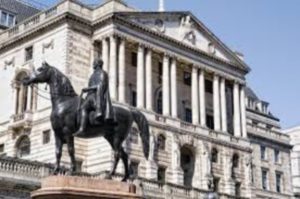Bank of England paper blows the whistle on bank lending
John Hermann
Readers might recall previous articles which appeared in ERA Review, with the titles
Sir Mervyn King states that banks create money [1]
The BoE’s sharp shock to monetary illusions [2]
Mainstream economists do not understand banking [3]
BoE dismisses misconceptions about money creation [4]
During the past two years the Bank of England seems to have been happy to publish accounts of money creation by banks as described in articles written by its own economists. Notable in this regard are papers by Michael McLeay [5], and by Zoltan Jakab and Michael Kumhof [6].
I am grateful to Prof Bill Mitchell, whose blog of 1st June [7] drew my attention to the last referenced item, titled Banks are not intermediaries of loanable funds – and why this matters, and to another article on this topic by John Kelly [8] which discusses the same paper.

In a nutshell, this BoE paper states that the bank loanable funds story that can be found in textbooks written by some of the world’s best known economists is complete nonsense. The paper says:
“ The currently dominant intermediation of loanable funds (ILF) model views banks as barter institutions that inter- mediate deposits of pre-existing real loanable funds between depositors and borrowers. The problem with this view is that, in the real world, there are no pre-existing loanable funds, and ILF– type institutions do not exist.”
This statement clearly removes any doubt about the erroneous view that commercial banks are intermediaries between their retail depositors and borrowers. It also means that many current economics courses which teach how banks operate in the real world are pie in the sky.
The paper also confirms what a range of heterodox economists like Steve Keen and Bill Mitchell have been saying for a long time, that commercial banks are not constrained by their holdings of banking reserves, any more than the world’s central banks are constrained by tax receipts.
In addition to demolishing the bank intermediation story, the BoE paper buries the wrongly conceived money multiplier explanation of banking, which is also to be found in many orthodox economics textbooks. On this the paper says:
“ in the real world, there is no deposit multiplier mechanism that imposes quantitative constraints on banks’ ability to create money in this fashion. The main constraint is banks’ expectations concerning their profitability and solvency.
“ in the real world, the key function of banks is the provision of financing, or the creation of new monetary purchasing power through loans, for a single agent that is both borrower and depositor.
“ The bank therefore creates its own funding, deposits, in the act of lending. And because both entries are in the
name of customer X, there is no inter- mediation whatsoever at the moment when a new loan is made. No real resources need to be diverted from other uses, by other agents, in order to be able to lend to customer X.”
The BoE is not the first central bank to recognise or acknowledge that the world’s mainstream economics text- books are seriously flawed. In 2008 the U.S. Federal Reserve (FRBNY), in the September issue of its Policy Review, made a similar admission [9].
In his blog, Bill Mitchell wrote:
“ The problem is that the core of the mainstream approach is wrong – at the elemental level – and economists refuse to give up these notions because if they did the whole edifice of the macroeconomic theory they preach would fall to the ground. The whole shebang is flawed and of no use for those keen to understand how the monetary system operates.”
The implications of this have been summarised by John Kelly as follows:
“ This paper is a vindication of Modern Monetary Theory taught by a small number of economists …
…as a sovereign nation and a monopoly currency issuer, we are not constrained in our spending other than by our ability to produce goods and services, other- wise recognised as our GDP.
“ This renders the concept of national debt and borrowing redundant. It renders the question, ‘How are we going to pay for it?’ redundant. It renders all the ‘debt and deficit disaster’ rhetoric redundant. And it renders the government’s case for fiscal austerity redundant. “
References
-
Tekelova, M., Sir Mervyn King states that banks create money; ERA Rev., v4, n6, p25
-
Keen, S., The BoE’s sharp shock to monetary illusions; ERA Rev., v6, n3, p1
-
Hermann, J., Mainstream economists do not understand banking; ERA Rev.,v6, n4, p2
-
Editor, BoE dismisses misconceptions about money creation; ERA Rev., v6, n5, p3
-
McLeay, M., Money creation in the modern economy; BoE Quart. Bull., Q1, 2014
-
Zoltan, J. & Kumhof, M., Banks are not intermediaries of loanable funds – and why this Matters; BoE Working Paper No 529, May 2015
-
Mitchell, W., Bank of England finally catches on – mainstream monetary theory is Erroneous; Billy Blog, 1 June 2015 http://bilbo.economicoutlook.net/blog/
-
Kelly, J., Bank of England Blows the Whistle; AIM network, 3 June 2015,
-
Todd, K., Martin, A. & McAndrews, J., Divorcing Money from Monetary Policy; FRBNY Econ Policy Rev., Sept 2008.



















